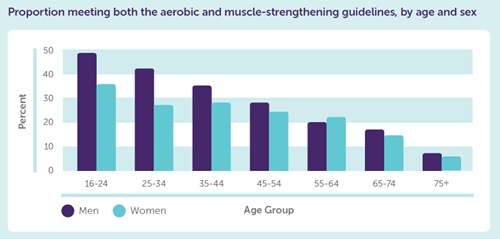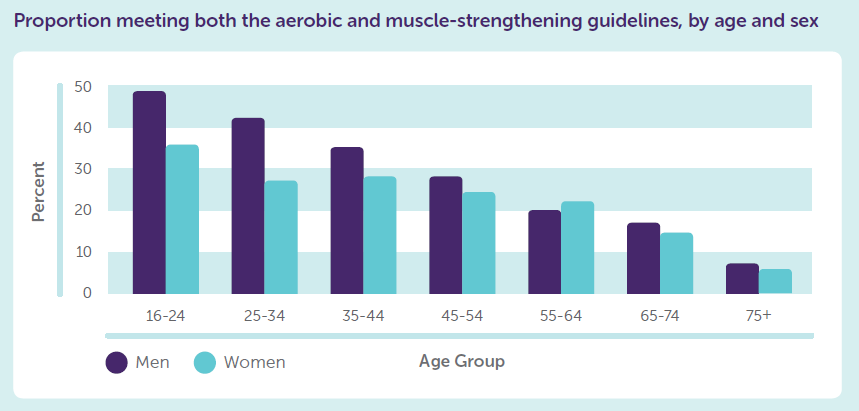The role of workplaces to support wellbeing for people in mid to later life
During GreaterSport’s Workplace Wellbeing focussed week, Beth Mitchell, GreaterSport’s Active Ageing lead explores strength and balance within the workplace.
Share
Beth highlights the simple ways key evidence-based activities can be integrated into the working day, to support employee's health and wellbeing, helping to prepare for a healthy later life.
Why is strength and balance important for our wellbeing?
Taking part in strength and balance can support our overall wellbeing. The World Health Organisation (WHO) showcases how physical activity more broadly, can be a key protective factor to supporting healthy ageing. The more we can do to maintain our strength, balance and bone health, the more likely we are to maintain independent living as we age. We know that our overall wellbeing is heavily influenced by our ability to take part in the activities that bring us happiness day to day, and the longer we are able to do this, the more fulfilling our lives will be.
One of the main factors and reasons why it is important to maintain our strength and balance, is due to the associated and increased risk of falls. A report commissioned by the Centre for Ageing Better explained that ‘Maintaining and improving muscle strength and ability to balance is crucial in reducing risk but also critical in helping people live independently as they get older.’ Further research by the Centre for Ageing Better: ‘Keeping on Moving: Understanding Physical Inactivity among 50–70-year olds’, also shows that maintaining independence now and for the future is a key psychological motivator to wanting to increase activity levels for people in mid to later life.
Why Strength and balance in mid-life?
As we know, we start to lose muscle and bone strength as we get older. We are also aware of the modifiable risk factors associated with a lack of muscle weakness and poor balance, such as falls leading to injuries, and in some cases hospital admissions and accessing social care (Raising the Bar on Strength and Balance, Centre for Ageing Better, 2019). Charlie Foster from Public Health England (2018), highlighted that it is far more important to take part in muscle strengthening activities across the life course to prepare for later life.
The graph below shows that as we reach mid-life, and in a lot of cases, are still members of the workplace, this is when we start to see a worrying decline in our muscle strength and this can be an integral part of our lives where we can start to reduce this trajectory.

Figure 1: Proportion meeting both the aerobic and muscle-strengthening guidelines, by age and sex (Raising the bar on strength and balance, The Centre for Ageing Better, February 2019). 
How can the workplace play a role in supporting strength and balance?
In February 2021, the Centre for Ageing Better highlighted how there are several changes to our population and workforce specifically; there is an increasing number of older people in the workforce: the rising number of people age 50+ in the population, and rising retirement ages. As an employer or employee, have you ever thought about how you can support your employees or peers to prepare for later life, and improve their strength and balance while in the workplace or when working from home? We know that our lives are busy and finding the time to take part in activities that improve our strength and balance can be difficult. But how about if we tried to integrate as much as possible into our working day to make sure that we are achieving the recommended guidelines? There are some simple messages and exercise that you can do during your working day, or even before you start work such as:
- Heel raises whist brushing your teeth in a morning, or waiting for the kettle to boil when making your morning brew.
- Performing a ‘sit to stand’ whilst at your desk to improve leg strength but also to reduce time spent sedentary during the working day.
- Standing during meetings and making this socially acceptable within the workplace to do so. You could even try standing on one leg, using your chair for support if needed. You can change legs after holding for 10 seconds.
Here is the link to the evidence-based ‘Super Six’ exercises for improving strength and balance. You could even put a poster up in your office as a reminder?
There are other resources which can support you to be more active in general as a workplace, contributing to overall health and wellbeing. Why not look at the Active Workplaces toolkit for simple, effective messaging and ideas to support your workforce? Activities such as:
- Walking meetings or taking a daily mile on your lunch break
- Cycling or walking to work, and if you’re working from home, try a walk around the block as a ‘commute’ before you sit at your desk
- Creating an ‘active soles’ culture, switching to informal soles or trainers to support people to move more comfortably during their day.
For further details on how to support your employees to integrate strength and balance into their day-to-day activity, please contact Beth Mitchell, Active Ageing lead at GreaterSport or John Brady, Strategic Lead of Active Adults, GreaterSport.
Latest News

GM Moving Sports Club Conference 2025
The role sports clubs play in enabling active lives for all: the GM Moving Sports Club Conference

GM Moving and Noisy Cricket to host joint event looking at movement and social care
GM Moving and partners will come together in February to look at how we engage the social care workforce in person-centred care.

What We’re Learning From Place: Reflections From Across Greater Manchester
Nicole McKeating- Jones our Strategic Lead for Place shares her thoughts on the annual reflections of the Place Partnership work across Greater Manchester.
